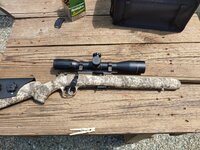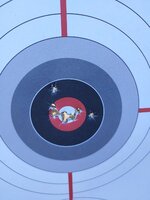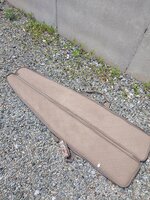ResearchinStuff
WKR
Disclaimers up front: I'm not Form, I haven't met the guy, I didn't touch a rifle a single time on active duty, and I now have a desk job. I'm new to FFP scopes, and this amateur mini evaluation did not perfectly follow the established testing standard, mostly because I was unprepared and didn't have the whole thing memorized. The mini-eval and drops were performed mostly for me to validate whether or not any of the stuff discussed in this sub-forum has merit and to assess whether having a drop-resistant rifle platform is an achievable objective. When in the mountains, particularly if it's snowy, I fall at least daily. I'm posting this mostly for people with similar questions, and to hopefully help normalize thorough individual gear testing in the community.
Scope Evaluated: SWFA 3-15 FFP, a SampleList Demo-C find.
This testing was performed at 15 yards, on a 22 that was right out of the box so I don't have a typical accuracy cone, thousands of logged rounds, or anything like that. The ammo used was some cheapo Remington Yellow Jacket that I've had laying around for over a decade. It probably came from Walmart, and it always goes bang, that's about the most I can say for its quality.
The test platform I used is a Savage Mark II FV-SR, the action screws (and the goofy little pillar/bolt things the action screws go into) were degreased and torqued to 50 inch-lbs, but not loctited. The scope rail is held to the gun with 4x 8-40 screws and a healthy amount of jb-weld (no release agent) under the rail since the original 6-48 screws were stripping out the receiver threads at less than 2 in-lbs of torque. Rings are Nightforce standard duty (2 screws per ring, 1 screw per side), torqued to Nightforce ring manufacturer specs and following Form's scope mounting procedure, minus the nail polish.

The bullseye target shows the pre-test zeroed condition.

This soft rifle case fully opened up and laid on compacted gravel was the drop surface.

The tests I performed, all aiming at the orange sticker:
5 shots where the elevation turret was turned to max, to min, and back to zero between each shot,
1 shot after a 6" drop to the left side
1 shot after a 6" drop to the right side
1 shot after a 6" drop on the top of the scope
1 shot after a knee-height drop on the left side
1 shot after a knee-height drop on the right side
1 shot after a knee-height drop on the top
1 shot after a waist height drop on the left
1 shot after a waist height drop on top
1 shot after a waist height drop on the right
1 shot after 3 waist height drops on the left side
1 shot after 3 waist height drops on the right side
1 shot after 3 waist height drops on the top
I did somewhat cheat the drop test in that I caught the gun after the initial bounce from the waist height drops so it didn't land on the actual gravel, I was concerned that might scratch a lens, but the primary fall and impact still occurred. A bigger drop surface would be needed to allow the drops to occur and naturally damp to completion, the bounce back from the high drops was more than 6".

Bottom line, this setup, including the SWFA 3-15, seems immune to drops up to waist height. The as-zeroed group is at 2 o'clock from the orange dot, there is no discernable difference in the group sizes or point of impact. If anything, it shot a tighter group as I was deliberately messing with the scope.
Comments on Glass Quality:
After doing the drops, the 100-yard firing line opened up and I was able to do some longer range shooting (this is a 22 folks, not a centerfire). I did have some issues at 100 yards getting the target image perfectly clear, I think the main culprit was the diopter, which I have always struggled to set correctly on every scope I own. I was however able to see the 22 cal impact holes on every part of the target that wasn't black, even with a noticeably imperfect image. My 5-year-old sunglass lenses that are delaminating weren't helping the image quality, but overall the system was good enough to make well-aimed shots.
Twilight observations:
I have previously tested this scope (unmounted) at dusk, and was able to resolve the reticle and "aim" at 27 minutes past legal sunset across an open field. In the woods, or on the west side of a ravine I think the reticle would have been lost earlier, as the field is definitely a brighter environment, particularly at my house, which sits near the crest of a very gentle slope (3 miles wide) and has almost a mile of untimbered land to the west.
Miscellaneous:
Interestingly, I noticed that I was able to hold better, and shoot tighter groups with the magnification backed off and between 6x and 9x than maxed out at 15x. Having never backed off the magnification when shooting groups, I was surprised by this discovery.
Bottom Line:
My limited testing validates a lot of what Form claims around here. If you're skeptical or curious about any of his claims or mine, you owe it to yourself to try it out and draw your own conclusions.
Scope Evaluated: SWFA 3-15 FFP, a SampleList Demo-C find.
This testing was performed at 15 yards, on a 22 that was right out of the box so I don't have a typical accuracy cone, thousands of logged rounds, or anything like that. The ammo used was some cheapo Remington Yellow Jacket that I've had laying around for over a decade. It probably came from Walmart, and it always goes bang, that's about the most I can say for its quality.
The test platform I used is a Savage Mark II FV-SR, the action screws (and the goofy little pillar/bolt things the action screws go into) were degreased and torqued to 50 inch-lbs, but not loctited. The scope rail is held to the gun with 4x 8-40 screws and a healthy amount of jb-weld (no release agent) under the rail since the original 6-48 screws were stripping out the receiver threads at less than 2 in-lbs of torque. Rings are Nightforce standard duty (2 screws per ring, 1 screw per side), torqued to Nightforce ring manufacturer specs and following Form's scope mounting procedure, minus the nail polish.

The bullseye target shows the pre-test zeroed condition.

This soft rifle case fully opened up and laid on compacted gravel was the drop surface.

The tests I performed, all aiming at the orange sticker:
5 shots where the elevation turret was turned to max, to min, and back to zero between each shot,
1 shot after a 6" drop to the left side
1 shot after a 6" drop to the right side
1 shot after a 6" drop on the top of the scope
1 shot after a knee-height drop on the left side
1 shot after a knee-height drop on the right side
1 shot after a knee-height drop on the top
1 shot after a waist height drop on the left
1 shot after a waist height drop on top
1 shot after a waist height drop on the right
1 shot after 3 waist height drops on the left side
1 shot after 3 waist height drops on the right side
1 shot after 3 waist height drops on the top
I did somewhat cheat the drop test in that I caught the gun after the initial bounce from the waist height drops so it didn't land on the actual gravel, I was concerned that might scratch a lens, but the primary fall and impact still occurred. A bigger drop surface would be needed to allow the drops to occur and naturally damp to completion, the bounce back from the high drops was more than 6".
Bottom line, this setup, including the SWFA 3-15, seems immune to drops up to waist height. The as-zeroed group is at 2 o'clock from the orange dot, there is no discernable difference in the group sizes or point of impact. If anything, it shot a tighter group as I was deliberately messing with the scope.
Comments on Glass Quality:
After doing the drops, the 100-yard firing line opened up and I was able to do some longer range shooting (this is a 22 folks, not a centerfire). I did have some issues at 100 yards getting the target image perfectly clear, I think the main culprit was the diopter, which I have always struggled to set correctly on every scope I own. I was however able to see the 22 cal impact holes on every part of the target that wasn't black, even with a noticeably imperfect image. My 5-year-old sunglass lenses that are delaminating weren't helping the image quality, but overall the system was good enough to make well-aimed shots.
Twilight observations:
I have previously tested this scope (unmounted) at dusk, and was able to resolve the reticle and "aim" at 27 minutes past legal sunset across an open field. In the woods, or on the west side of a ravine I think the reticle would have been lost earlier, as the field is definitely a brighter environment, particularly at my house, which sits near the crest of a very gentle slope (3 miles wide) and has almost a mile of untimbered land to the west.
Miscellaneous:
Interestingly, I noticed that I was able to hold better, and shoot tighter groups with the magnification backed off and between 6x and 9x than maxed out at 15x. Having never backed off the magnification when shooting groups, I was surprised by this discovery.
Bottom Line:
My limited testing validates a lot of what Form claims around here. If you're skeptical or curious about any of his claims or mine, you owe it to yourself to try it out and draw your own conclusions.
